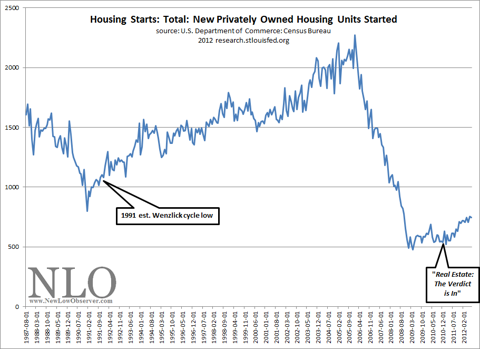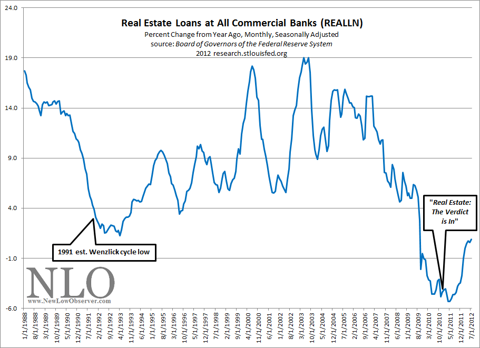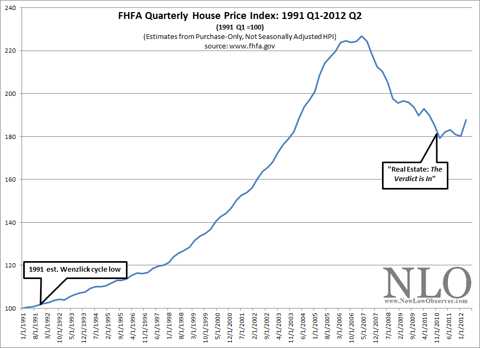For years, some real estate analysts feared that banks would suddenly release a wave of foreclosed houses, swamping the local housing market and sending house prices into a second collapse.
That second tsunami isn't happening, according to an analysis by the North County Times.
A house-price crash precipitated a series of foreclosure spikes in 2007 and 2008, leaving banks holding thousands of houses and struggling to hire staff to process them.
After 2009, real estate agents and some analysts became convinced that lenders were holding off on foreclosures, and sitting on foreclosed properties in order to prop up prices, creating a "shadow inventory."
They feared lenders would have to process and release all those houses ---- sending house prices, which have been bouncing along a price bottom for two years, into another downward spiral.
Instead, the number of homes in default has been steadily declining in the region, thanks to a host of programs from government and private banks and a turn toward short sales, in which borrowers sell their properties for less than they owe.
And once lenders have foreclosed on properties, they have moved quickly to sell them, so the stock of properties held by banks is declining, according to an analysis of foreclosure data by the North County Times.
No conspiracy
"The idea that the banks are intentionally doing anything is itself ridiculous," said
Chris Thornberg, a principal and an economist with Beacon Economics near Los Angeles. "There's not some Illuminati of banks. They're not holding back units, they're selling them as fast as they can."
Thornberg has long argued against a second wave of foreclosures, but other analysts worried about the shadow inventory.
Tim Ellis, an analyst at national real estate brokerage Redfin, has been among the most concerned, writing on
Redfin's blog in February: "The fact remains that the banks are currently sitting on tens of thousands of homes across the country that they have foreclosed and not yet listed, along with tens of thousands more homes somewhere in between the first missed payment and the actual foreclosure.
"... Any sign, however slight, that prices may be on the rebound will cause banks to release more of their inventory onto the market, along with a wave of pent-up supply from would-be sellers on the margin to rush to list their homes to take advantage of the 'recovery.'"
Locally, the sentiment was similar.
Seeing shadows
"There's a lot of shadow inventory,"
Jeff Jenkel, a Rancho Bernardo real estate agent, said in May. "And so at some point it's going to get a lot worse before it gets better."
Even
Douglas Duncan, chief economist for government lending giant Fannie Mae said in December, "The shadow inventory has to be worked through."
Do lenders hold properties off the market? Chase Bank responded to the North County Times' question, speaking only for themselves:
"No," said
Lisa Shepherd, vice president of Chase REO and property preservation. "The only time that you would see a property that's not available for sale that goes through foreclosure is if it's in some sort of legal action that prohibits me from selling it."
Lenders sold off the majority of homes they foreclosed, according to a North County Times analysis of foreclosure data from
ForeclosureRadar and transactions from the San Diego and Riverside county assessor's offices.
Fire sale
Between Jan. 1, 2007, and June 30 this year, lenders foreclosed on 16,570 houses in North San Diego County. By the end of that period, lenders held 780 houses ---- they'd sold off 95 percent of the houses they'd taken back.
The same trend holds for Southwest Riverside County over the same period: Lenders foreclosed on 36,037 houses, and by the end of June possessed 1,625, which is to say, they sold 95.5 percent of all the houses they'd foreclosed.
At a peak in fall of 2008, lenders held 1,315 houses in North County and 3,173 houses in Southwest Riverside.
If the lenders had the capacity to drop all those houses on the market right away, they probably could have affected prices: All those houses would have represented one-third of North County listings in the period, and half of Southwest County listings. Even this year, if lenders put all their houses on the market, it would change pricing.
But lenders can't flip a house instantly, said Shepherd from Chase.
"If the property is vacant and there are no issues, it should be anywhere from 30 to 45 days to get it on the market," she said. To sell the property, "on average, and especially in the state of California, anywhere from 60 to 90 days."
Inventory turns over
In 2007, lenders needed a median of 10 months to sell a house they'd just foreclosed on. By 2008, they needed a median of six months. At the end of 2011, they'd reduced that median to four months, in North San Diego and Southwest Riverside counties.
"What that means is rather than mismanaging things and holding things back, they (lenders) are reducing their inventory." said G.U. Krueger, a housing economist with Krueger Economics in Los Angeles.
Even as lenders have become more efficient at selling the houses they foreclose on, they're also foreclosing on fewer of them, largely thanks to government refinance and loan modification programs, private loan modification programs, and a new focus on short sales.
Those programs have helped lower the number of people in default. In San Diego County, as of June 30, there were 6,539 people in default on their loans but not yet foreclosed, down 35 percent from three years earlier, according to ForeclosureRadar. The number of people in default in Riverside County fell 34 percent over the same period to 8,821.
Those programs also have sharply reduced the number of foreclosures in the region: In July, lenders foreclosed on 223 houses in Southwest Riverside and on 126 houses in North County.
The result has been a steep decline in the number of houses available for prospective buyers ---- listings in both regions are down one-third from a year ago, according to the North San Diego County Association of Realtors and Redfin.
The tight inventory of homes for sale has led to
bidding wars among buyers for the first time since the boom ended in 2006, and a
stabilization of home prices in the region.
"People are starting to come out and buy homes," said
Nathan Moeder, an economist and principal with London Group in San Diego. "There's going to be demand to suck up those homes."


















![[image]](http://s.wsj.net/public/resources/images/OB-UI651_smbtng_NS_20120828184727.jpg)










